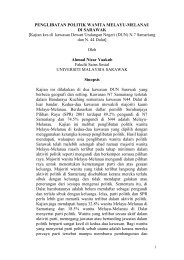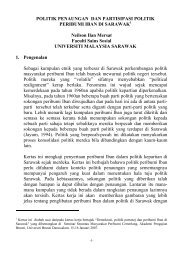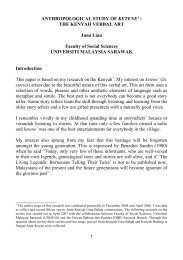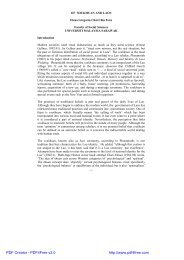RUBBER AND THE MODERNISATION OF THE PAKU IBAN IN ...
RUBBER AND THE MODERNISATION OF THE PAKU IBAN IN ...
RUBBER AND THE MODERNISATION OF THE PAKU IBAN IN ...
You also want an ePaper? Increase the reach of your titles
YUMPU automatically turns print PDFs into web optimized ePapers that Google loves.
This, according to Kedit, could only be “ponder within the whole context of<br />
modernization” (p. 144). In his study, Kedit classifies the Ibans into three<br />
categories: the traditionalist, the intermediary, and the modernist. The Paku<br />
Iban, he said, are of the intermediary and modernist types. In comparison, the<br />
Lubok Antu Iban are of the traditionalist type. Kedit believes the determining<br />
factor in this is not education, nor occupation, or religion (christianity vs Iban<br />
traditional religion), but the environment.<br />
The processes of change that took place among the Paku Iban, especially in<br />
the 1950s, could be attributed to the planting of rubber in Paku in the early<br />
decades of 1900s. The aim of this paper, therefore, is to show how rubber has<br />
influenced entrepreneurial development of the Paku Iban and how this has led<br />
to the adoption of a new culture.<br />
2. Study Area<br />
The study area is called the Paku Ulu area. Paku is made of up of two main<br />
Penghulu jurisdictional areas: Paku Ili (lower Paku) and Paku Ulu (upper<br />
Paku). Paku Ili constitutes of tidal areas and is swampy, while Paku Ulu is the<br />
fresh-water areas and hilly. The soil in Paku Ulu is suitable for rubber planting.<br />
Paku River is a tributary of the Saribas River. Within the Iban community in<br />
Sarawak, Paku is considered to be an old country (menoa lama). It is one of<br />
the areas first occupied by the Ibans in Sarawak. According to Clifford Sather<br />
(1990), the Ibans have settled in the Paku region more than fourteen<br />
generations ago.<br />
Normally, when people talk about the Paku region, they usually refer to the<br />
Paku Ulu area due to its wealth in natural resources compared to Paku Ili.<br />
Paku Ulu is more developed and richer than Paku Ili. For example, Paku Ulu<br />
is accessible by road since 1967 while Paku Ili only in the late 1990s. Even<br />
then not all longhouses in the Paku Ili area are affected. Paku Ulu already has<br />
amenities such as electricity supply and telephone services, while Paku Ili still<br />
does not have these facilities even though it is much closer to Betong and<br />
2







